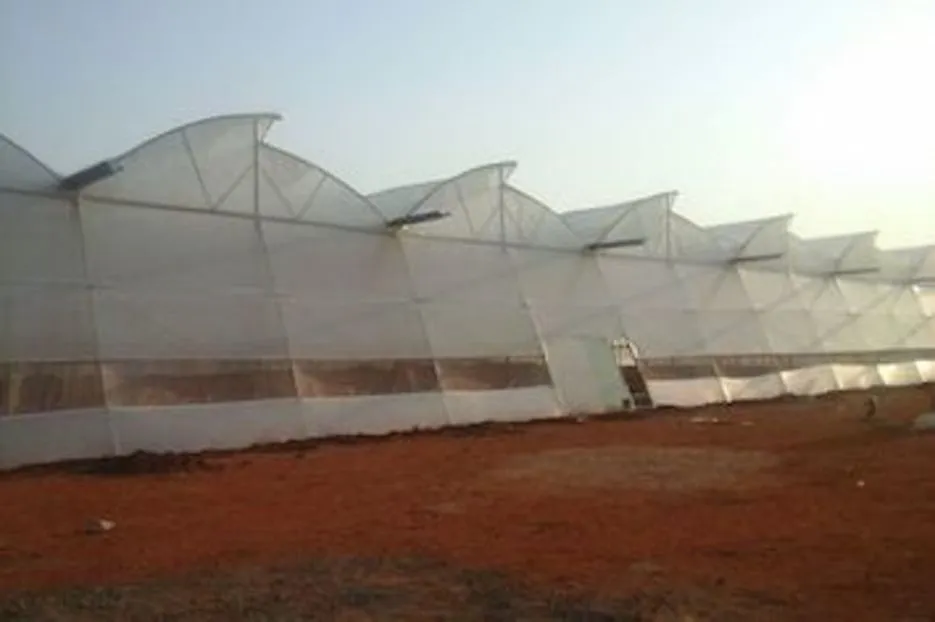 மீண்டும்
மீண்டும்

Types of Polyhouses:
Types of Polyhouses:
Based on the environmental control system, polyhouse are of two types:

◙ Naturally ventilated polyhouse - This type of polyhouse does not have any environmental control system except for sufficient ventilation and fogger system to save the crops from bad weather conditions and natural pests and diseases.


◙Environmental controlled polyhouse - They are constructed with much-controlled conditions primarily to extend the growing period of crops or to increase the off-season yield by controlling the light, temperature, humidity, etc.

Point to consider before selecting Polyhouse site:
Point to consider before selecting Polyhouse site:
The durability of the polyhouse is more compared to other types of Greenhouse. Before deciding to start greenhouse farming, you have to consider the following point to become successful in greenhouse farming
- Soil pH should be between 5.5 to 6.5 and EC (Volatility) 0.3 to 0.5 mm cm/cm
- Good water quality is continuously available.
- The irrigation water samples should be range from pH 5.5 to 7.0 and E.C. 0.1 to 0.3
- The selected place should be pollution-free.
- There should be roads for transportation and shipping of goods in the market.
- The place should be large enough for the upcoming expansion.
- Workers should be available easily and cheap.
- There should be excellent communication facilities in place.
- The drainage of the soil should be excellent
- List of tools
► Polythene sheet- 200-micron thickness


►ISI quality based G.I pipes
►40 mesh insect proof nylon net
►40-100 micron mulching sheet
► Thermometer and hygrometer
► Foggers
► Heating and temperature adjusting tool
►Solar pump
Size of Polyhouse
Size of Polyhouse

A bigger greenhouse would have more temperature build-up especially if there is no proper ventilation. In case of naturally ventilated greenhouse, the length must not exceed 60m.
Polyhouse Construction cost
Polyhouse Construction cost
Polyhouse construction cost depends on the type of polyhouse that is being adopted. The price undoubtedly increasing when moving towards high-tech from low-tech.
✓ The cheapest polyhouse construction can cost around Rs 500 per meter square without the addition of fans and pads.
✓ Medium tech polyhouse with pad and fan can cost up to Rs 1000 per meter square given there is no automation system employed
✓ The last is the costliest which is the high-tech polyhouse with all modern machinery and fully automated systems. They can cost up to Rs 4000 per square meter starting from Rs 2000 per square meter depending on the equipment.
The net profit that can be earned through polyhouse cultivation is estimated to be around 6-7 lakhs per acre per annum which exclude the polyhouse farming cost. It is a pretty good source of income as well and at the same time is good for the environment and to maintain the quality of the crops.
Height
Height
A 50m X 50m greenhouse can attain a maximum height of 5m. A taller greenhouse would have a larger wind load for the glazing and structure.
Management of cost-effective poly houses:
Management of cost-effective poly houses:
Temperature: It affects the germination, flowering, pollination, fruit set, and quality of product and seed production. Generally, the temperature requirement range is 20°C to 30°C during day time and 15°C to 18°C during night time.
Light: The performance of crop is influenced by three aspects of light namely intensity, quality and duration. Greenhouse shading material of 20 to 90% shade value can be used.
Humidity: The acceptable range of humidity is between 50-80%. During summer, humidity can be maintained by fan-pad and humidifier.
Ventilation: Ventilation can either be natural or forced. However, fan ventilation is essential to have control over air temperature, humidity and carbon dioxide level.
Irrigation/ Nutrition: The water requirement for soil-based substrates is at the rate of 20l/sq.mt. of the bench and 0.3 to 0.35litres per 16.5cm diameter pot. The nutrient requirement of a crop is generally high inside the cover due to high-density planting in comparison with the conventional method under open conditions.
Thank you for reading this article, we hope you clicked on the ♡ icon to like the article and also do share it with your friends and family now!








